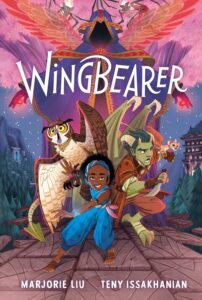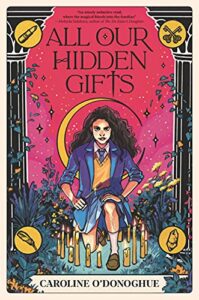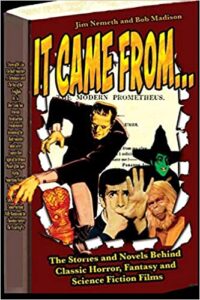Wingbearer (Wingbearer Saga #1) by Marjorie Liu, art by Teny Issakhanian
Quill Tree, 2022
ISBN-13: 9780062741165
Available: Hardcover, paperback, Kindle, Comixology
Buy: Bookshop.org | Amazon.com
Marjorie Liu takes a step away from horror and dark fantasy with her middle grade graphic novel, Wingbearer. Zuli, raised in the Great Tree by mysterious bird spirits, is unique. She doesn’t look at all like the bird spirits, and she has never seen anyone like her. She has never left the safety of the branches of her home. When an evil magic begins to affect the new growth of the tree and bird souls are not returned to its branches for rebirth, Zuli sets out to spread her wings with her guardian owl, Frowly, to discover the problem and return the bird souls home. Zuli is also on a quest to discover who she is and where she comes from. Along the way, she meets new friends and foes, and perhaps comes face-to-face with her biggest threat or salvation, the Witch-Queen.
Upon seeing the world beyond the Great Tree, she finds the land ravaged, broken ruins everywhere. Her first encounter with any other living creature is when she is attacked by giant spiders. She discovers this world is not what she was hoping and dreaming about in the safe branches of her home. Throughout her journey, she also finds that not everything is black and white: there are grey areas that she must grapple with. A memorable scene is when she becomes distraught after she sees other goblins in her friend Orien’s camp chopping tree branches for building materials and fuel. She does not understand why the destruction of even one branch of a tree is necessary for others to live. Zuli grapples with other philosophical and identity-related themes, as well as having to learn new things.
Liu’s creative power is in her world building, and Wingbearer does not disappoint. She creates a complex world without bogging down the story with too much detail, and everything is cohesive and well-constructed. As with her Monstress series, she fills the world with compelling and driven characters, each with their own motivations and personalities shining through. For instance, Zuli’s friendship with the goblin Orien progresses in a very real way, with philosophical and cultural conflict, as well as learning more about each other.
Teny Issakhanian, an Armenian-American artist, provides lush and beautiful illustrations. She really brings the characters to life, the emotion in their facial expressions is so powerful. The bird spirits are particularly beautiful. Her previous work includes DreamWorks TV Animation, Disney TV Animation, and the Jim Henson Company.
Reading Wingbearer was like revisiting past Dungeons and Dragons games for me. High adventure, magic, good and evil butting heads, interparty conflict…all the great stuff from RPGs. For parents wanting to introduce their kids to the fantasy genre, Liu and Issakhanian would be a great first read. This is the first of the series, and I am very much looking forward to the second volume. Highly recommended.
Reviewed by Lizzy Walker







Follow Us!